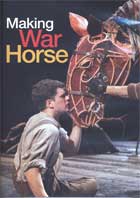
Making War Horse 2010
Distributed by Microcinema International/Microcinema DVD, 2169 Folsom Street, Suite M101, San Francisco, CA 94110; 415-447-9750
Produced by National Theatre, Seventh Art Productions, Phil Grabsky, David Sabel, and Toby Coffey
Directed by David Bickerstaff and Phil Grabsky
DVD, color, 48 min.
Jr. High - General Adult
Animal Behavior, Children’s Literature, History, Military Studies, Theater, World War I
Date Entered: 03/14/2012
Reviewed by Caron Knauer, La Guardia Community College, Long Island City, New York“The first thing the Handspring puppets are taught to do,” England’s National Theater’s co-director Tom Morris says, “is to breathe.” The magic that one particularly celebrated horse puppet, Joey, breathes into our times is charted in the first documentary commissioned by the theater. This captivating film tells the story of the development of the award-winning UK production of War Horse. In-depth interviews with all of the key creative forces, on and off stage, provide an incredibly detailed behind-the-scenes of the groundbreaking hit play. Based on Michael Morpurgo’s eponymous 1982 children’s book. War Horse, it debuted in 2007, came to Broadway in 2011 and in 2012 shows no sign of slowing down in New York and London. The play also spawned Steven Spielberg’s epic and majestic Academy Award-nominated film.
After seeing a Handspring production of a giraffe story in Cape Town, Morris was eager to work with the South African-based company, whose co-founders, Adrian Kohler and Basil Jones, describe their innovative technical creations. Morris’s mother suggested that he read Michael Morpurgo’s beloved story War Horse. He read it and loved it, as did Kohler and Jones, and they were all inspired to tell a war story from the neutrality of a horse’s point of view. Morpurgo created Joey because he “wanted to avoid writing a story about World War I that was from one side or another, but was about the universal suffering of war”. Eight million horses were killed during the war; a million were from England. But the theatrical collaborators worried about the challenges of doing a story from a horse’s point of view without him speaking. As Nicholas Hytner, the theater’s director said, having him speak would be “anathema.” The writer Nick Stafford, who adapted the book for the stage, talks about the challenges of not only telling a theatrical story from a horse’s point of view, but from a first person story adaptation. He says a “third person story lends itself much more to adaptation.”
Once the script was written and approved, the puppeteers began the work of creating a life size horse and conveying its weight. While showing the horse moving forward, the audience sees its powerful muscle structure. The puppeteers inside the horse move it via rods, and a pole on the outside is manipulated to move its neck. The puppeteers are physically strapped into the mechanism, and as they can’t see what the person behind them is doing, they have to learn strategies to stay in synch. A puppeteer explains how they utter a certain sound, like a snort, and use it as a signal to move. When Kit Harington, the actor who plays Norbert Narracott, Joey’s master, was preparing for the role, he spent a lot of time with horses. But when he met Joey, he says, he experienced him as a “living, breathing horse” and “didn’t have to project anything upon him.” Lighting and costume designers, as well as scenery and musical artists are also interviewed.
Hytner lauds the British theater’s commitment to War Horse and other groundbreaking work, and claims “it is the only place this production could have been done.” Nick Starr, the theater’s executive director, says that “the message of the story might be sentimental, but what’s going on is more complicated.” The production has given his colleagues “the ability to experiment and to yoke people together with a common purpose.” The DVD’s many extras include extended interviews and video diaries. This wonderful film displays the wonders and the enduring legacy of creative collaboration at its most inspired.